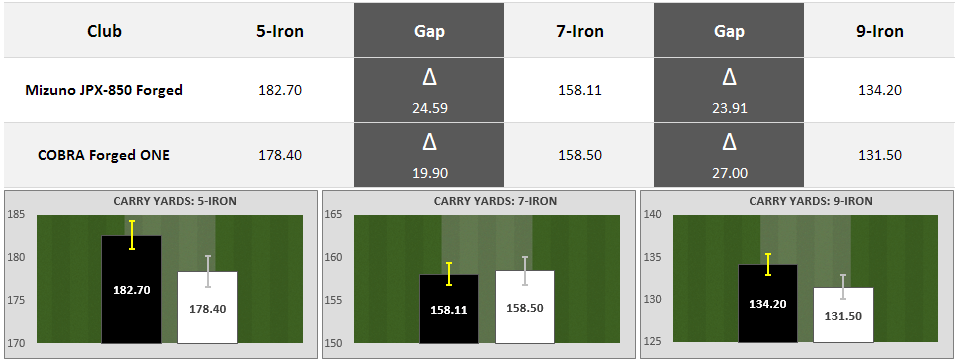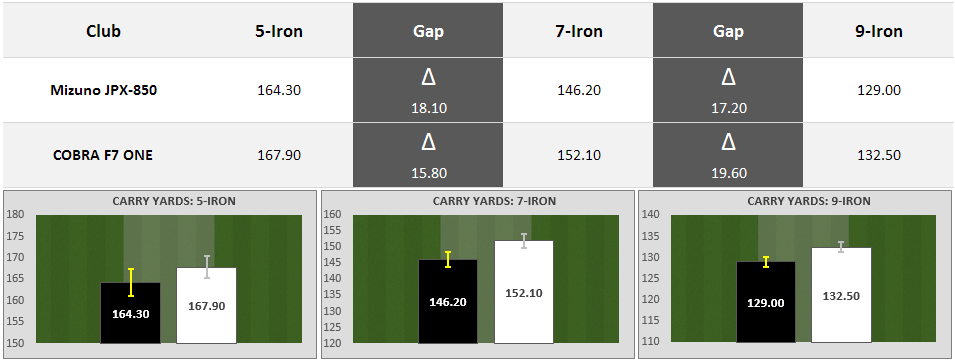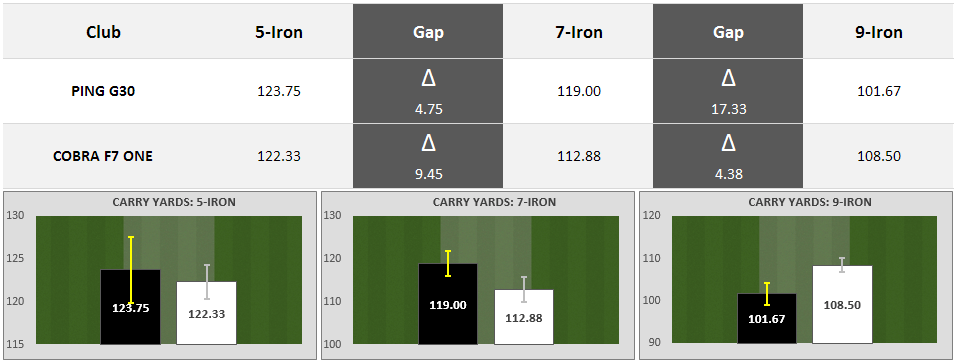There’s More (because some of you asked for it)
Welcome to the unplanned Part 2 of our detailed look at Cobra’s F7 ONE and Forged ONE Irons.
After reading yesterday’s post, several of you expressed a wish… maybe a desire… to have a better look at the gapping data from the test. As it turns out, that was something I wanted to do anyway, so I thank you for providing the justification to spend a little more time in Excel (hooray) to pull that together.
But before we get to round 2 of our charts, there are a couple of points we should discuss.
Consistency vs. Ideal Gapping
First, you should understand that with its ONE Length products, Cobra isn’t nearly as concerned with gapping as it is about consistency. They’ve studied real-world yardage gaps (provided by Arccos) and found big overlaps with variable length clubs. Basically, inconsistent ballstriking already leads to inconsistent gaps. So while its competitors might point to robot-replicated gapping issues as a shortcoming of ONE Length, the real-world data from the Arccos universe suggests the average golfer’s gaps are basically a mess anyway. Cobra’s single length philosophy centers around helping the golfer hit better shots more often.
And that brings me to consistency. We talked about this yesterday, but I thought it was important to included our carry yardages/consistency charts again today, and here’s why.
One of the things we talk about quite a bit internally is that averages don’t tell the whole story. Consider 2 separate (3) shot samples from a theoretical 7-iron:
- The first produces carry yardages of 145, 155 and 165 yards.
- The second produces carry yardages of 149, 150, and 151 yards.
The average of the first set is 5 yards longer, but wouldn’t you prefer the consistency of the second? Do it again with a 5-iron, and a 9-iron, etc. Tweak the numbers on the second set so that our gaps aren’t perfect, but the consistency of the individual irons remains intact. Now which set of clubs would you rather have in your bag?
I’ll willingly concede that this is a well-polished example, and that few of us would be that consistent, even with single length irons. The larger point I’m trying to illustrate is that consistency matters more than most of us give it credit for. To a reasonable degree, gapping can be addressed with a Mitchell machine, consistency depends on your relationship with your clubs.
I should also note that Cobra believes that as on-course familiarity with ONE Length improves, those error bars in the charts below will shrink, and scores will come down. That part remains to be seen, but I’m anxious to find out. Spring can’t get here soon enough.
About the Charts
Before we dig in, just a couple of quick notes on the charts. The dark gray columns contain the yardage deltas between the 5 and 7 irons and the 7 and 9 irons. The closer those two numbers in each row are to one another, the better the gapping. In a perfect world, these values should be somewhere between 20 and 30 yards (10-15 yards between clubs). As you’ll see, we didn’t see much of that with either set.
As mentioned above, I’ve included our carry charts, which included standard error bars. Interpretation is simple. The shorter the bar, the more consistent the carry yardage. More consistent is good.
So as you look at the charts, I’d ask that you consider both gapping and consistency.
Finally, if there’s anything I haven’t covered, anything I left out, or any questions I haven’t answered, holler at me. I’ll do my best to get you the info (whatever it happens to be).
Tester 1: High Swing Speed – USGA Index: 4.6
Observations:
- Tester 1 has consistent (and nearly ideal) gaps with his gamers.
- ONE Length gaps are inconsistent due to decreased distance in both the 5 and 9 irons.
- While the differences in consistency between his gamers and Forged ONE appear small, the narrow margins do favor the gamers.
Tester 2: High Swing Speed – USGA Index: 18.5
Observations:
- Tester 2 has reasonably consistent, though large, gaps with his gamers.
- Data suggests that by keeping his 5-hybrid instead of the F7 ONE 5-Iron, the gaps would be consistent.
- As you would expect from a higher handicap player, consistency is poor with both sets.
Tester 3: Mid Swing Speed – USGA Index: 2.5
Observations:
- Tester 3 has more consistent but slighlty large gaps with his gamers.
- ONE Length gaps are less consistent due to the shorter 5 iron.
- A hybrid could potentially level the gaps.
- 5 and 7 iron consistency favor the ONE Length, while this tester was more consistent with his 9-iron.
Tester 4: High Swing Speed – USGA Index: 10.7
Observations:
- Tester 4’s gamer gaps are more consistent due to a significant increase in 7-iron distance with the F7 One.
- While gamer gaps are more consistent, they are far from ideal (too narrow).
- Replacing the 5-iron with a hybrid would likely lead to significantly better gapping with F7 One.
Tester 5: High Swing Speed – USGA Index: +.4
Observations:
- Tester 4’s gapping with the Forged One is consistent, though perhaps a bit narrow.
- Poor gapping with the gamer set is attributable to abnormally short distance with the 7-iron.
- 5-iron consistency is better with the tester’s clubs, however, middle and short irons favor Forged ONE.
Tester 6: Mid Swing Speed – USGA Index: 8.6
Observations:
- Tester 6 showed better gapping with his gamers, however, with both sets the gaps are narrower than is ideal.
- Uneven gaps from the F7 ONE are attributable primarily to distance gains with the 7-iron.
- The F7 ONE produced more consistent carry distances across all 3 irons tested.
Tester 7: Low Swing Speed – USGA Index: 17.5
Observations:
- Tester 7’s gaps are more consistent with the F7 ONE, however, by no means is gapping close to ideal with either set.
- The gapping issues shown in the charts are far from uncommon with senior and other slower swing speed golfers.
- Replacing the 5-iron with a hybrid would significantly improve gaps.
- Carry distances are more consistent with the F7 ONE.
Tester 8: Mid Swing Speed – USGA Index: 10.5
Observations:
- Tester 8’s gaps between the 7 and 9-iron are solid for both sets, but the data suggests this tester would benefit from replacing the 5-iron with a hybrid.
- Gapping is similar for both sets.
- 5 and 9-iron consistency favors the Forged ONE, while 7-iron consistency favors the gamers.
Tester 9: High Swing Speed – USGA Index: 12
Observations:
- Tester 9’s gaps are more consistent, though a bit narrow, with the gamer set.
- The difference is attributable to a modest distance loss with the 5-iron coupled with a modest distance gain with the 7-iron.
- The Forged ONE produced more consistent carry distances.
The Big Picture
Our interpretation of the data is that the variable length irons (the gamers) produced moderately better gapping for most testers, however; in very few instances did either set produce what we would classify as ideal gapping. Keep in mind that manufacturers often design clubs (and that includes loft specifications) to the middle – and that means they can’t possibly account for all of our swing speeds or the unique ways each of us delivers the club to the ball.
It’s also next to impossible to account for the inconsistency of impact you get from average golfers. We suspect that in an overwhelming majority of cases, the only way to ensure proper gaps (or at least as close to proper as most of us can get), is to work with a qualified fitter who can adjust each iron loft independently as needed to dial in the requisite average distance.
More to Come… maybe
As I mentioned in yesterday’s post, we may publish additional single length case studies in the future. We’re also planning on taking a closer look at Cobra’s ONE Length wedges.

























Chuck
7 years ago
I had just recently purchased these “Cobra One Length” clubs. For me, I have a back injury and nerve damage in my neck, so after going to the local golf store and testing them out, well I got them. After two rounds, I can honestly see a difference. I will repost after a few months, but I see a more enjoyable game and lower scores in my future. Thanks Cobra..
Mark
6 years ago
And the repost results?